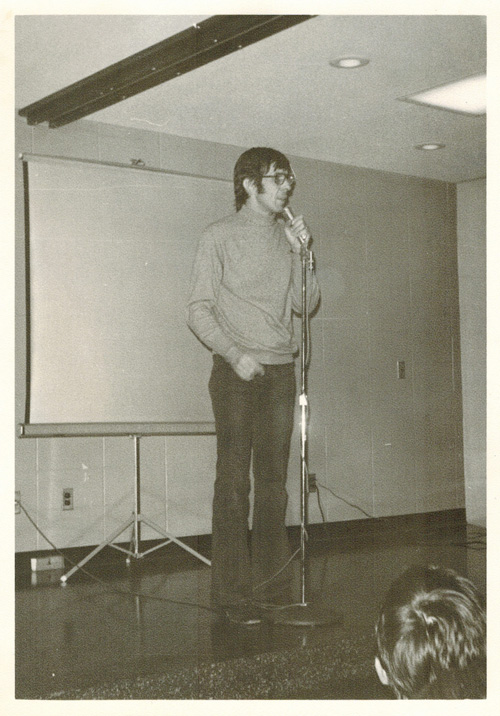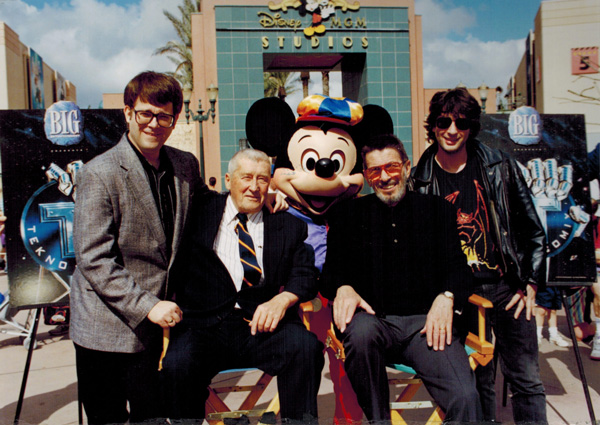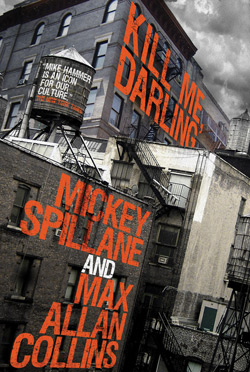The eccentric and self-aggrandizing mystery writer Michael Avallone liked to show people pictures of himself and Gene Kelly, standing together in a suburban front yard, with the great song-and-dance man’s arm slung around the pulp writer’s shoulder, both men grinning. Donald E. Westlake said to me about this photo, “The only way that could have happened is if Gene Kelly fell out of a plane.”
So the fact that I have a couple of photos of Leonard Nimoy, with me in them (that’s the back of my head in one), doesn’t mean we were pals. I doubt I made much of any impression on him. But he made an impression on me.
In the late ‘60s and early ‘70s, when I was commuting to the University of Iowa in Iowa City from Muscatine (where I still live), Barb and I were in the early days of our marriage. We lived in a little two-room apartment with kitchenette and bath, where I wrote BAIT MONEY while Barb worked at the bank (the one I had Nolan and Jon rob in that novel).
Our first big shared enthusiasm (okay, our second big shared enthusiasm) was STAR TREK, which we began watching during its third season (I was aware of the show but my band the Daybreakers had our regular rehearsal on the night it aired) (no VCRs yet). Shortly after that, STAR TREK reruns began to appear in the late afternoon. I usually got home in time to see an episode.
When my schedule didn’t allow that, I lingered in Iowa City at my pal Mike Lange’s apartment, which he shared with three or four other nerds. Mike and I had been in a vocal quartet that won State every year of high school. He was one of the original sweater-vest-and-briefcase geeks and was very funny, sometimes on purpose. Barb and I called him an “incompetent Spock.” The best way to understand who Mike was is best demonstrated by his asking a waitress, “What is the ETA of a tenderloin?” Years later, Mike would join us for the various STAR TREK movies, invariably on opening night, starting with STAR TREK: THE MOTION PICTURE, which we stood in the snow for several hours to see.
I suppose Barb and I were Trekkies, but the word wasn’t in wide use yet, at least not in Iowa. We went to one of the first ST conventions, in Detroit, where we met Gene Roddenberry, James Doohan, Majel Barrett (later to appear in my film MOMMY) and various writers from the show; I believe “The Menagerie” in black and white was shown. Around that time, I also somehow got in touch with Walter Koenig, who was a Big Little Book collector; we made some trades, and became friends, meeting up at several comic-book conventions. Very smart, nice guy, and an excellent writer. We’ve stayed in sporadic touch over the years.
We also went to see William Shatner, appearing in “The Seven Year Itch” at Pheasant Run dinner theater in Illinois; he was funny and energetic, as you might expect. This was in the early ‘70s. He signed autographs (including my copy of THE TRANSFORMED MAN) and was friendly but bewildered by the many STAR TREK fans who wanted to discuss a series that had been cancelled five or six years before. He said unequivocally that STAR TREK was dead (I asked him, “What about the rumors of rebirth for the series?” and he said, “More like afterbirth.”) I remain a big Shatner fan.
But of course the STAR TREK character and actor who had the Baby Boomers most in his thrall was Spock/Nimoy. The dignity, the humor, the humanity of that characterization spoke to so many things in my generation, not the least of which (pun intended) a shared alienation. Even more than Shatner, however, Nimoy felt captive to his ST role – the ears played a part in that – and it took him decades to understand the importance of his pop-cultural contribution, and to embrace it.
It needs to be said that the chemistry between Nimoy, Shatner and the great Deforest Kelley was the real engine of the show, thrusters be damned. That stroke-of-luck casting for three well-defined characters is the real reason why we are still looking at and talking about that 79-episode, late-‘60s science-fiction series.
In the ‘70s, Barb and I went to see Nimoy in a number of plays. One was THE FOURPOSTER, at another Illinois dinner theater, a matinee in a huge theater-in-the-round with maybe a dozen of us in attendance. Nimoy and his co-star, whose name I don’t recall, gave their all. I was very impressed. Later we saw Nimoy as a very strong Sherlock Holmes in a big, revamped version of the wheezy Gillette play; this was in a big Chicago theater and co-starred LAUGH-IN’s Alan Sues as Moriarty.
The most memorable Nimoy appearance for us was at a small political rally in the basement of the student union at NIU in DeKalb, Illinois, in October 1972. Nimoy was appearing to encourage young, first-time voters to get out and put anti-war candidate George McGovern in the White House. He gave a warm, smart speech, and we were in or near the first row. While we were McGovern supporters, Barb and I were there for Nimoy, of course. (This event, oddly enough, was just written up by me as a part of QUARRY IN THE BLACK.)

Leonard Nimoy speaking at NIU, 1972.
Barb and I were, in those years, very dedicated TREK fans. We still are, but as the fan phenomenon grew sillier and more shrill, we kind of reluctantly faded into adulthood. At the same time, as I said above, opening day for a STAR TREK film was our church (we also still worshiped at the temple of James Bond opening days) (still do). And Nimoy was an actor, and later director, who I continued to follow with admiration.
In the early ‘90s, when Tekno-Comics – by way of my late good friend Marty Greenberg – invited Mickey Spillane and me to create a comic book (MICKEY SPILLANE’S MIKE DANGER), the various celebrity creators of the various titles in that line were gathered at several events. Leonard Nimoy had created an s-f title, LEONARD NIMOY’S PRIMORDALS, which put me in the same room with him a number of times.

M.A.C., Mickey Spillane, Mickey Mouse, Leonard Nimoy, Neil Gaiman
At a Disneyworld event, specifically a luncheon, I mentioned that Barb and I had seen him in several plays, including SHERLOCK HOLMES. We spoke about Holmes for a while – Nimoy played him in a short film, as well – and he had a clear love for the character (according to Nicholas Meyer’s STAR TREK: THE UNDISCOVERED COUNTRY, Holmes is an ancestor of Spock – and Meyer should know). I found Nimoy reserved but friendly, very Spock-like actually.
Later that same year, at a Griffith Observatory event, he was coming down an aisle with his lovely wife and I was coming up the aisle with my lovely wife. Surprisingly, he remembered me, sticking out his hand for me to shake, and flashed that great smile that is always so shocking coming from Spock. We spoke for just a minute or so, but…well, it was a moment I won’t forget. Maybe I am a Trekkie.
He died at 83. As someone said, that sounds really old, unless you’re a man of 82. I am a man of 66, who will turn 67 on the day this update appears, and 83 sounds less old than it used to. But it’s tough to have a better life, at least in terms of art and career, than Leonard Nimoy. He turned Spock into a cultural icon as well as a character of enormous appeal and power, mostly by underplaying. He appeared in numerous other TV shows and movies, and directed some as well; he was a skillful writer, one of the few poets I ever bought books by, and was a respected fine-arts photographer. Yes, I am going to say it. He lived long and prospered.
Just not long enough.
Here is an absolutely terrific, starred review of KILL ME, DARLING by Spillane/Collins.
It’s the mid-1950s. Four months ago, private eye Mike Hammer’s partner and girlfriend, Velda, left him without any sort of explanation. Mike leapt feet first into a bender, a four-month drunk; when this superb, old-school crime novel opens, he’s addicted to the booze and uninvolved in the world. His best friend, NYPD captain Pat Chambers, tells Mike he had better get his act together because Velda has turned up in Florida, hanging on the arm of a big-time gangster, and Velda’s boss from her undercover-cop days has turned up dead, the victim of a mugging that looks suspiciously like murder. So Mike heads off to the Sunshine State, determined to pull his head out of the bottle and find out why Velda left him—and, just maybe, to pull her out of whatever hole she’s put herself in and bring her back home. This latest collaboration between Hammer’s creator, the late Spillane, and noted crime writer (and frequent Spillane coauthor) Collins is based on an unfinished Spillane manuscript, but it reads seamlessly; in fact, it’s impossible to tell which parts were written by Spillane and which were written by Collins. Yes, it’s a new book, but it feels like something from 60-odd years ago, when Spillane’s prose was young and raw and full of energy. For Mike Hammer’s fans—yes, there are still plenty of them out there—it’s a sure bet. — David Pitt
Ron Fortier, fine writer in his right (righter in his own write?)
This review of QUARRY’S CHOICE is favorable but suggests you may need a shower after reading it. Why not? I’m all in favor of cleanliness.
Here’s an interesting if patronizing essay/article on Mickey Spillane.
Here’s a nice mention of QUARRY’S CHOICE from my old pal Chris Mills (he did the great Perfect Crime “Van Cleef” covers for the NOLAN reprints). Beautiful look at the McGinnis cover.
Finally, check out this excellent, darn near in-depth look at MS. TREE.
M.A.C.
